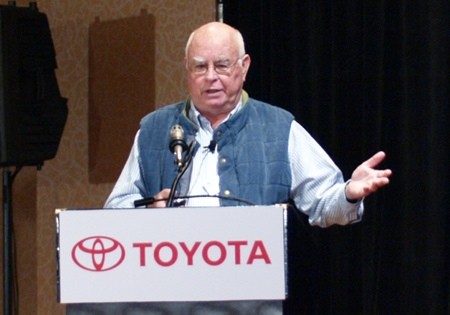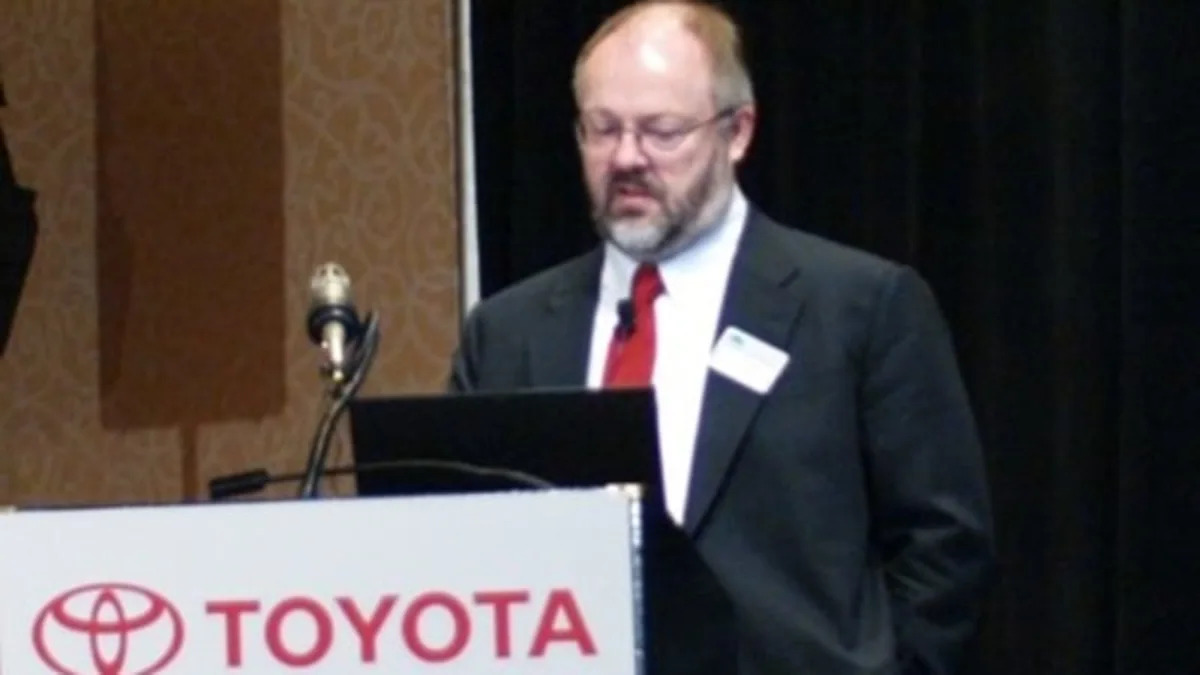As we gathered sleepily in the conference rooms early in the morning, host John Hanson said that Toyota's hope with this one-day seminar was to present the complexity of the sustainability mobility situation and to highlight the challenges that the world is dealing with. The solution is not just the cleaner-than-they-used-to-be four-wheeled vehicles that Toyota is building, but also its partnerships and transportation alternatives, a reduction in how much energy and resource we use, better regulations, and so on and so on and so on. Seriously. By 3 p.m., our heads were swimming but still, Toyota succeeded in Hanson's stated goal. The six or so hours of presentations and Q&A sessions provided a lot of answers and raised a few questions about just what we're going to do in the coming decades. If nothing else, we learned that Toyota is thinking about the problem.
Follow us past the jump for the full story.
The first speaker of the morning was Dr. Peter Wells (above), who talked about "The Peak in World Oil Supply." Toyota was setting the stage very clearly starting at 8 a.m. Wells, a great fan of nuclear power because it's the only industrial solution that can provide the energy capacity needed around the world that can supplant oil, has spent a long, long time researching the world's oil supply and he knows that there will be no great changes up or down coming in the next decade or so.
During the 1980s, a price floor of around $18-20 a barrel was set, determined by the needs of the Saudi Arabian budget, and Wells said that a lot of analysts are still living in that world, while there was plenty of excess capacity and the challenge oil producers had was to stimulate demand. Now, though, we live in a world with very little spare capacity, maybe around 1,500,000 barrels a day. A hurricane in the Gulf of Mexico, for example, can wipe out that excess out overnight, and so the price of a barrel of oil is much less stable than it was throughout the last 20 or so years.
There are two ways to get more oil out of an oil field: enhanced oil recovery and field upgrades. While both can get more oil out today, it's only the EOR that really adds to our supply. EOR means we've discovered a new technology – miscible non-hydrocarbon gas, for example – that allows us to get at oil that would've remained in the ground without this new technology. A field upgrade, which is what most of the "new oil" we hear about in the news is, is simply using a technology like horizontal drilling that gets the oil we would've gotten anyway out faster. Sure, this upgrade is better for the economics of the field now, Wells said, but it doesn't really add any oil to the overall global supply, and all of Wells' models show a serious decline from this point forward, especially in the non-OPEC oil sources. "We still have a lot of oil to go," he said, "it's just that it's not increasing, which is a huge difference for the market."
Speaking of OPEC, they're in no great rush to increase production. If they do, the result would be lower oil prices. Why would you work harder to make less money? They're not totally against production increases, especially considering the spare capacity competition between Iran and Saudi Arabia, Wells said. These two countries broke ranks with Jan Kreider standard and now others are following suit in order to not lose market share. Wells said that Venezuela, Iraq, Iran and Saudi Arabia all have plenty of production capacity, but they have all agreed to an upper production limit. All told, OPEC could add 10 million barrels a day of capacity (mid-case) if they wanted to. Political situations, though, mean that there's no guarantee we'll ever see that oil.
The peak for world liquids (meaning oil, as well things like biofuels and Canadian tar sands) production will happen sometime between 2017 and 2023 and it'll be set at around 100 million barrels of oil a day. Mitigation measures – using non-gasoline sources for transportation, using more of each barrel of oil for transportation (by not using the heavier parts for home heating, for example) – are possible, but this deadline is looming and carmakers need to be prepared for major fluctuations in price, Wells said, and they need to offer vehicles that a variety of energy inputs and overall more efficient engines.
You can listen to Well's full presentation here (56 min):
while you click along with the presentation here (should probably open the slides in another tab):
Follow us past the jump for the full story.
The first speaker of the morning was Dr. Peter Wells (above), who talked about "The Peak in World Oil Supply." Toyota was setting the stage very clearly starting at 8 a.m. Wells, a great fan of nuclear power because it's the only industrial solution that can provide the energy capacity needed around the world that can supplant oil, has spent a long, long time researching the world's oil supply and he knows that there will be no great changes up or down coming in the next decade or so.
During the 1980s, a price floor of around $18-20 a barrel was set, determined by the needs of the Saudi Arabian budget, and Wells said that a lot of analysts are still living in that world, while there was plenty of excess capacity and the challenge oil producers had was to stimulate demand. Now, though, we live in a world with very little spare capacity, maybe around 1,500,000 barrels a day. A hurricane in the Gulf of Mexico, for example, can wipe out that excess out overnight, and so the price of a barrel of oil is much less stable than it was throughout the last 20 or so years.
There are two ways to get more oil out of an oil field: enhanced oil recovery and field upgrades. While both can get more oil out today, it's only the EOR that really adds to our supply. EOR means we've discovered a new technology – miscible non-hydrocarbon gas, for example – that allows us to get at oil that would've remained in the ground without this new technology. A field upgrade, which is what most of the "new oil" we hear about in the news is, is simply using a technology like horizontal drilling that gets the oil we would've gotten anyway out faster. Sure, this upgrade is better for the economics of the field now, Wells said, but it doesn't really add any oil to the overall global supply, and all of Wells' models show a serious decline from this point forward, especially in the non-OPEC oil sources. "We still have a lot of oil to go," he said, "it's just that it's not increasing, which is a huge difference for the market."
Speaking of OPEC, they're in no great rush to increase production. If they do, the result would be lower oil prices. Why would you work harder to make less money? They're not totally against production increases, especially considering the spare capacity competition between Iran and Saudi Arabia, Wells said. These two countries broke ranks with Jan Kreider standard and now others are following suit in order to not lose market share. Wells said that Venezuela, Iraq, Iran and Saudi Arabia all have plenty of production capacity, but they have all agreed to an upper production limit. All told, OPEC could add 10 million barrels a day of capacity (mid-case) if they wanted to. Political situations, though, mean that there's no guarantee we'll ever see that oil.
The peak for world liquids (meaning oil, as well things like biofuels and Canadian tar sands) production will happen sometime between 2017 and 2023 and it'll be set at around 100 million barrels of oil a day. Mitigation measures – using non-gasoline sources for transportation, using more of each barrel of oil for transportation (by not using the heavier parts for home heating, for example) – are possible, but this deadline is looming and carmakers need to be prepared for major fluctuations in price, Wells said, and they need to offer vehicles that a variety of energy inputs and overall more efficient engines.
You can listen to Well's full presentation here (56 min):
The video meant to be presented here is no longer available. Sorry for the inconvenience.
while you click along with the presentation here (should probably open the slides in another tab):

Up next, Dr. Tim Barnett. Barnett's talk described the realities of water in the Western U.S. I'm including it here for completeness but he didn't really talk about how this affects cars and automakers (the connections were pointed out later in the day). The takeaway point is that only, and this is important, only the impact of human activities explain the climate change that's happening in the Western U.S.
Listen here (34 min):
The video meant to be presented here is no longer available. Sorry for the inconvenience.
Watch here:


Sign in to post
Please sign in to leave a comment.
Continue